Abstract
Background:
According to World Oral Health report 2003, the prevalence of periodontitis is 86% in India. Dental care can sometimes be a forgotten part of a healthy life style. While its importance is often underestimated, the need for regular dental care cannot be overstated. Oral health has been neglected for long in India. The scarce literature on dental health awareness, attitude, oral health-related habits and behavior among the adult population in Rajasthan prompted us to assess the preventive oral health awareness and oral hygiene practices in patients attending outpatient department of Vyas Dental College and Hospital (VDCH), Jodhpur through this study.
Materials and Methods:
A total of 500 patients in the age group 15–50 years were selected using random sampling technique. A self-administered structured questionnaire including 16 multiple choice questions was given to them. The results were analyzed using percentage.
Results:
The result of this study shows an acute lack of oral hygiene awareness and limited knowledge of oral hygiene practices. In Jodhpur, few people use tooth brush.
Conclusions:
Hence, there is an urgent need for comprehensive educational programs to promote good oral health and impart education about correct oral hygiene practices.
Keywords: Motivation, oral hygiene practices, oral hygiene awareness
INTRODUCTION
India, sixth biggest country by area is the second most populous country. Factors contributing to the steady rise in prevalence of periodontal disease include poor oral health awareness. Annual health budget is 2% of Gross National Product but no specific budget is earmarked for oral health. Oral health knowledge is considered to be an essential prerequisite for health-related behavior.[1] Although only a weak association exists between knowledge and behavior in cross-sectional studies,[2,3] there are studies that establish an association between knowledge and better oral health.[4,5]
We keep reading about studies done to judge the oral health and oral hygiene practices at so many places scattered all across the globe. According to the literature, no study has been done to assess the oral hygiene awareness in Jodhpur till now, which, is the second largest city in Rajasthan with an area of 22,850 square km and population of 3,685,681. This study was therefore initiated in VDCH with a prime focus to determine the awareness levels among the patients visiting VDCH, Jodhpur, from Jodhpur's urban and rural localities.
Aims and Objectives
To assess the oral health awareness among people of Jodhpur, Rajasthan
To learn about their oral hygiene practices
To provide insight into educational programs that have to be organized by health care professionals.
MATERIALS AND METHODS
A cross-sectional study was conducted among the patients attending the outpatient department of VDCH, Jodhpur. This proposed study was reviewed by the Institutional ethical committee and clearance was obtained. Five hundred patients were selected using a simple random sampling technique. Informed consent was obtained from each patient. A self-constructed 16-item close-ended questionnaire was distributed to all subjects above 18 years of age in English and was filled by a dental professional for illiterate persons [Figure 1].
Figure 1.
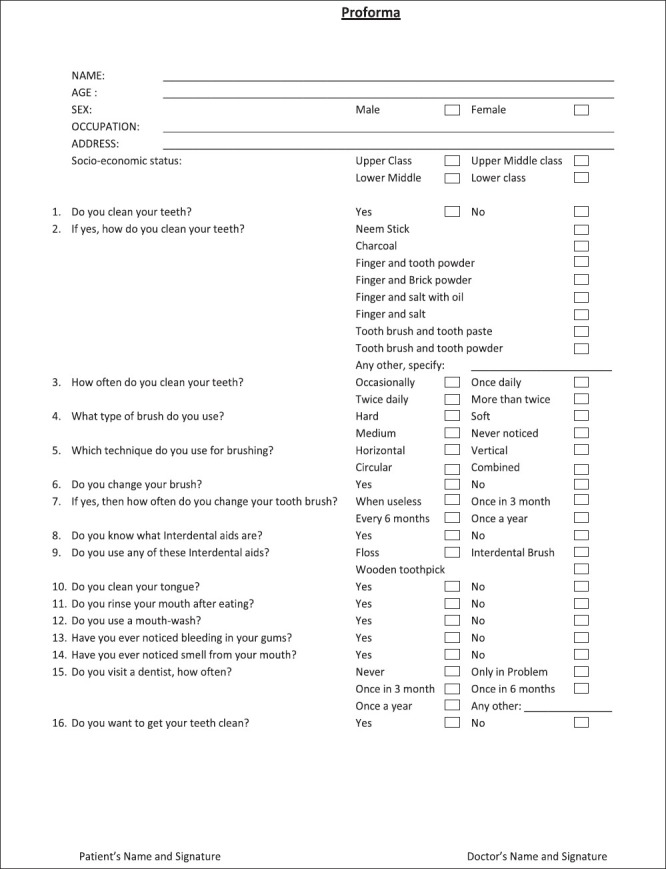
Questionare
The questionnaire included information related to the patient's name, age, gender, occupation, and residential area It was further categorized to evaluate the knowledge, practices, and behavior pattern related to oral health. After distribution of questionnaire, 10 min were allotted for completing the questionnaire. The completed questionnaires were then analyzed statistically to obtain the results in terms of percentages.
RESULTS
In the present study, questionnaire was distributed to 500 patients who were selected randomly. Of the 500 participants, 54% were male and 46% were female. Fifty-six percent of these participants were literate and the remaining 44% were illiterate.
Almost 58% of participants used tooth brush as a method to clean their teeth
In response to other methods of cleaning their teeth, 17% were using salt with finger, 18% indicated use of neem stick and 23% charcoal, 34% use tooth powder with finger, whereas 8% of the subjects even resort to using brick powder with finger [Figure 2]
Forty-four percent people brush their teeth occasionally, 33% of them were brushing once a day, 23% were brushing twice a day, and none of them brushed more than 2 times a day [Figure 3]
Approximately 50% of the participants were unaware about the type of tooth brush used by them and only 10% of the sample use soft tooth brush [Figure 4]
Around 75% of the subjects brush their teeth in horizontal direction, which is the most dangerous method of brushing [Figure 5]
None of the patients use dental floss
Only 10% uses mouth wash [Figure 6]
Although 40% noticed bleeding from gums, only 10% among them want to get their teeth cleaned [Figure 6]
Surprisingly enough, 50% of the population, visit dentist only in pain [Figure 7]
Only 20% of the sample cleans their tongue [Figure 8]
Twenty-nine percent of study sample rinse their mouth after eating a meal [Figure 8].
Figure 2.

Different types of cleaning methods other than tooth brushing
Figure 3.
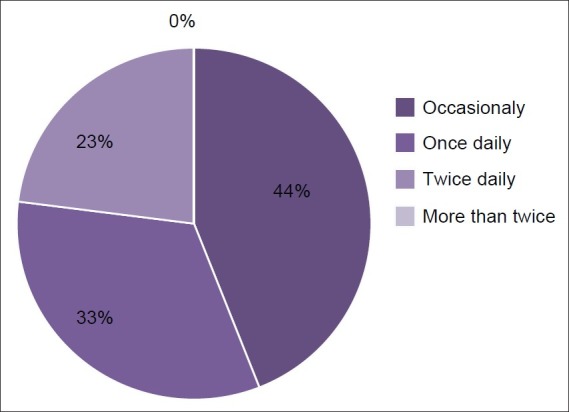
Brushing frequency
Figure 4.
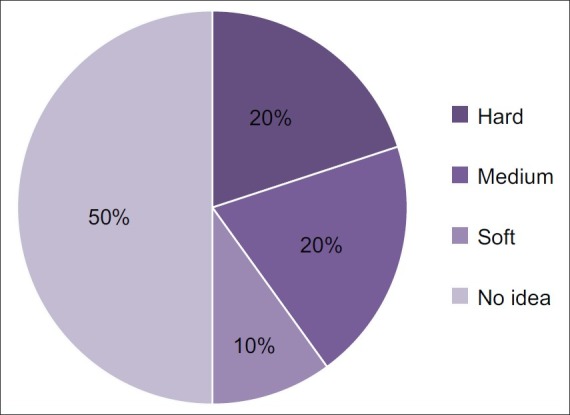
Types of tooth brush being used
Figure 5.
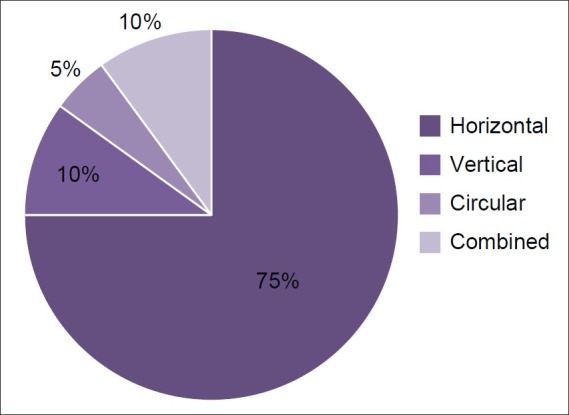
Different types of brushing technique
Figure 6.
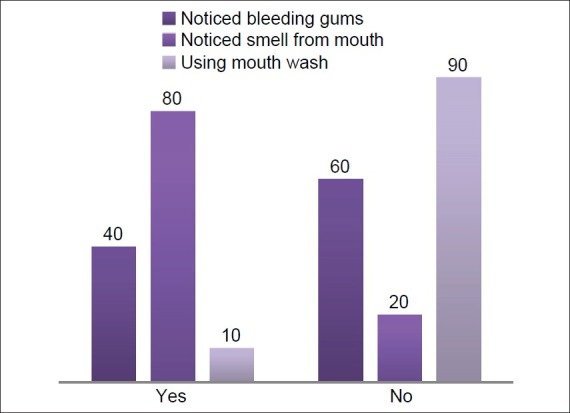
Percentage of people noticed bleeding from gums and smell from mouth
Figure 7.
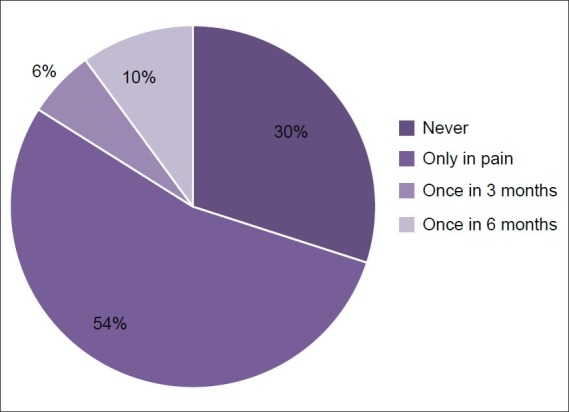
Frequency of dental visit
Figure 8.
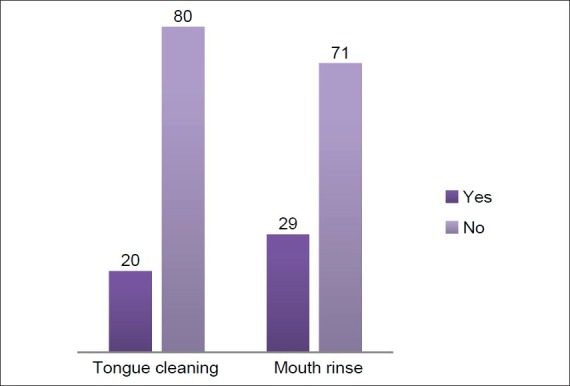
Percentage of people cleaning their tongue and using mouth wash
DISCUSSION
It has been observed that oral hygiene has mostly remained as an ignored and unrealized major social problem. Majority of the people are unaware about the relationship between oral hygiene and systemic diseases or disorders. Most diseases show their first appearance through oral signs and symptoms and they remain undiagnosed or untreated because of this missing awareness.
According to the consumer usage and attitudes study done in 2010, among the most shocking of revelations is that nearly half of the Indian population does not use a tooth brush and only 51% brushed their teeth using a tooth brush and toothpaste.[6]
Over the past 20 years a significant amount of emphasis has been made on prevention of diseases rather than the treatment aspect. Healthy teeth can last us a lifetime with the proper preventive dental care. Preventive oral health knowledge, behavior, and its practice are the important ways of keeping our teeth healthy. Hence, in this study attempts were made to evaluate preventive oral health knowledge, practice, and behavior of the population of Jodhpur.
Although brushing was the commonly used method of cleaning, the percentage of subjects brushing their teeth twice daily is 23% [Figure 3], which is very less as compared with 58% of the Police recruits in a study by Dilip,[7] 67% of the Chinese urban adolescents in a study by Jiang et al,[8] 62% of the Kuwaiti adults in a study by Al-Shammari et al,[9] and 50% of the middle aged and 75% of the elderly Chinese adults in urban areas in a study by Zhu et al.[10]
It is noteworthy that 75% of the respondents brushed their teeth using traditional horizontal method, which will jeopardize the tooth structure [Figure 5]. This finding is in agreement with that of the study done by Zhu et al.[10] where 60% of the sample did the same.
Only 10% of the subjects use soft brush, which is less than that observed among Zhu et al.'s subjects[10] where 27% of the sample uses the same.
Thirty percent change their toothbrush once in 3 months, and surprisingly 60% change their brush only when it is useless [Figures 4 and 9].
Figure 9.
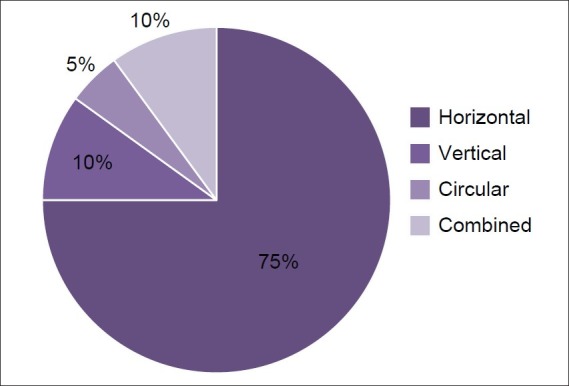
Percentage of people changing toothbrush
There is generally a failure in the use of dental floss as a preventive tool. None of the subjects has used dental floss, which is similar to a study conducted by Hanaa M. Jamjoom in Saudi Arabia in 2001.[11] In contrast, Hamilton and Couby found that a high percentage (44%) of the sample they studied in Northeastern Ontario used dental floss.[5] Reason for this may be the significant resource allocation to health education programs that are carried out in Canada. This emphasizes the urgent need for educating and motivating the public to use this efficient method for oral health care.
Only 20% of the studied population showed that they clean their tongue either with tooth brush or tongue cleaner. Also, only 29% of the sample population rinses their mouth after eating food. This missing and very basic method of maintaining oral hygiene is a clear indication of lack of awareness.
Ten percent of subjects used a mouth wash [Figure 10]. Interestingly enough, they used it to treat malodor.
Figure 10.

Frequency of changing toothbrush
Furthermore, 80% reported halitosis [Figure 10]. This study is in contrast with that of an epidemiologic survey of the general population of Japan where 24% of the individuals examined complained about bad breath.[12]
Forty percent of the total subjects reported bleeding gums. This study is in agreement with studies of Gilbert et al.[13] and Buhlin et al.[14] who showed that self-reported bleeding gums was high in percentage. This study is in contrast with the studies of Nagarajan and Pushpanjali in India,[15] Tervonen and Knuttila,[16] and Kallio et al.[17] who showed that most of the patients did not notice bleeding from gums.
Our study showed that 54% of the subjects visited a dentist when they were in pain, which is similar to the study done by Nabil Al-Beiruti, in 1997, where 69.5% of the participants reported visiting a dentist only when they have pain.[18]
Unsurprisingly, standards of oral health are very poor in India, with a large proportion of the population being affected due to poor socio – economic conditions. In addition to this, two thirds of people have never seen a dentist.
Missing awareness about the crucial role of regular dental checkups in preventing and detecting dental diseases is another gap in public education. As dentists, it is our responsibility to educate and motivate people to visit a dentist.
CONCLUSION
The indifferent results of this study in Jodhpur are a critical indicator of the task on hand, the task to spread awareness among the masses about Oral Hygiene. The information on developments in vital combination of Oral Hygiene, Oral Diagnosis, and overall health needs to be spread by us, the dentists. Establishing and demonstrating this connection will be critical to achieve this goal and this process will have to be taken at all levels including a definite beginning with our patients.
We, as dentists, will have to keep reinforcing the importance of correcting all aspects related with brushing and flossing along with the importance of regular checkups.
The task of spreading this awareness extends beyond our clinic to general masses and it will have to be achieved in a similar way by various outreach programs and relevant public health awareness measures through various mediums, such as Print/Press Media, Audio/Radio/Television, Internet, and Organizing Social Activities.
All of these and more innovative methods of reaching the public will not only ensure a healthy individual but a healthy society as well.
Footnotes
Source of Support: Nil
Conflict of Interest: None declared.
REFERENCES
- 1.Ashley FP. Role of dental health education in preventive dentistry. In: Murray JJ, editor. prevention of dental disease. 3rd ed. Oxford: Oxford University Press; 1996. pp. 406–14. [Google Scholar]
- 2.Freeman R, Maizels J, Wyllie M, Sheiham A. The relationship between health-related knowledge, attitudes and dental health behaviors in 14–16-year-old adolescents. Community Dent Health. 1993;10:397–404. [PubMed] [Google Scholar]
- 3.Kay EJ, Locker D. A systematic review of the effectiveness of health promotion aimed at improving oral health. Community Dent Oral Epidemiol. 1998;26:132–44. [PubMed] [Google Scholar]
- 4.Woodgroove J, Cumberbatch G, Gylbier S. Understanding dental attendance behavior. Community Dent Health. 1987;4:215–21. [PubMed] [Google Scholar]
- 5.Hamilton ME, Coulby WM. Oral health knowledge and habits of senior elementary school students. J Publ Health Dent. 1991;51:212–8. doi: 10.1111/j.1752-7325.1991.tb02217.x. [DOI] [PubMed] [Google Scholar]
- 6.Cosmetic dentistry guide: The consumer usage and attitudes survey. [Last accessed on 2010 Apr 16]. Available from: http://www.cosmeticdentistryguide.co.uk/news/survey-indicates-poor-standards-of-oral-health-inindia-9321 .
- 7.Dilip CL. Health status, treatment requirements, knowledge and attitude towards oral health of police recruits in Karnataka. J Indian Assoc Public Health Dent. 2005;5:20–34. [Google Scholar]
- 8.Jiang H, Petersen PE, Peng B, Tai B, Bian Z. Self-assessed dental health, oral health practices, and general health behaviors in Chinese urban adolescents. Acta Odontol Scand. 2005;63:343–52. doi: 10.1080/00016350500216982. [DOI] [PubMed] [Google Scholar]
- 9.Al-Shammari KF, Al-Ansari JM, Al-Khabbaz AK, Dashti A, Honkala EJ. Self-reported oral hygiene habits and oral health problems of Kuwaiti adults. Med Princ Pract. 2007;16:15–21. doi: 10.1159/000096134. [DOI] [PubMed] [Google Scholar]
- 10.Zhu L, Petersen PE, Wang HY, Bian JY, Zhang BX. Oral health knowledge, attitudes and behaviour of adults in China. Int Dent J. 2005;55:231–41. doi: 10.1111/j.1875-595x.2005.tb00321.x. [DOI] [PubMed] [Google Scholar]
- 11.Jamjoom HM. Preventive Oral Health Knowledge and Practice in Jeddah, Saudi Arabia. J KAU: Med Sci. 2001;9:17–25. [Google Scholar]
- 12.Miyazaki H, Sakao S, Katoh Y, Takehara T. Bad Breath: Research Perspectives. Israel: Ramot Publishing: Tel Aviv University; 1995. Oral malodor in the general population of Japan; pp. 119–36. [Google Scholar]
- 13.Nagarajan S, Pushpanjali K. Self-assessed and clinically diagnosed periodontal health status among patients visiting the outpatient department of a dental school in Bangalore, India. 2008;19:243–6. doi: 10.4103/0970-9290.42958. [DOI] [PubMed] [Google Scholar]
- 14.Gilbert AD, Nuttal NM. Self-reporting of periodontal health status. Br Dent J. 1999;186:241–4. doi: 10.1038/sj.bdj.4800075. [DOI] [PubMed] [Google Scholar]
- 15.Buhlin K, Gustaffon A, Anderson K, Hakansson K, Klinge B. Validity and limitations of self reported periodontal health. Community Dent Oral Epidemiol. 2002;30:431–7. doi: 10.1034/j.1600-0528.2002.00014.x. [DOI] [PubMed] [Google Scholar]
- 16.Tervonen T, Knuttila M. Awareness of dental disorders and discrepancy between objective and subjective dental treatment needs. Community Dent Oral Epidemiol. 1988;34:345–8. doi: 10.1111/j.1600-0528.1988.tb00579.x. [DOI] [PubMed] [Google Scholar]
- 17.Kallio P, Nordblad A, Croucher R, Ainamo J. Self-reported gingivitis and bleeding gums among adolescents in Helsinki. Community Dent Oral Epidemiol. 1994;22:277–82. doi: 10.1111/j.1600-0528.1994.tb02050.x. [DOI] [PubMed] [Google Scholar]
- 18.Al-Beiruti N. Oral health behaviour among a sample of schoolteachers, physicians and Nurses in the Syrian Arab Republic. East. Mediterr Health J. 1997;3:258–62. [Google Scholar]


